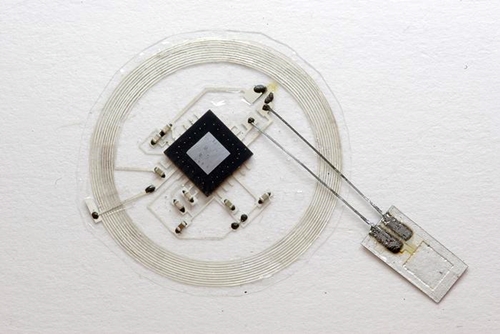
Tiny brain sensor later absorbed into the body. (Courtesy: John Rogers, University of Illinois)
19 January 2016. Engineers and medical researchers developed tiny, implanted sensors measuring brain functions in lab animals that dissolve and leave the body in a few weeks. The team from University of Illinois in Urbana and Washington University in St. Louis published its findings on 18 January in the journal Nature (paid subscription required).
Researchers from the labs of engineering and materials science professor John Rogers at Illinois and neurosurgeon Wilson Zachary Ray at Washington University are seeking better ways to monitor human bodily functions than today’s implantable electronic devices. While implanted sensor technology is advancing quickly, current implants still run risks of infection and undesired movement from their original locations, as well as often needing another invasive surgery for removal.
The team aimed to design miniaturized devices that operate independently for limited periods of time in the body, starting with sensors to monitor brain functions. The device, built by Rogers and colleagues at Illinois, is comprised of biodegradable silicon and polymer (PLGA) materials, with sensors smaller than a grain of rice. The device has a sensor to measure intracranial fluid pressure surrounding the brain, where increases in pressure are an indicator brain injury, as well as a temperature sensor.
The sensors are connected by thin wires to a radio frequency transmitter, about the size of postage stamp, implanted under the skin at the top of the skull. A later version directly attaches the sensor device to a communications module, showing the feasibility of eliminating wires, but the communications components in this version are only partially degradable.
Ray’s team at Washington University conducted proof of concept tests, first in lab simulations with saline solutions, and later implanting the sensor devices in lab rats. Their tests show the biodegradable sensors could read and transmit intracranial pressure and temperature as accurately as conventional permanent sensors. In a few weeks, the devices dissolved and were absorbed into the bodies of the rats.
While the journal paper reports on sensor devices implanted in brains, the researchers believe the idea can be extended to measure activity in other organs. “The ultimate strategy,” says first author and Washington University neurosurgeon Rory Murphy in a joint statement, “is to have a device that you can place in the brain, or in other organs in the body, that is entirely implanted, intimately connected with the organ you want to monitor and can transmit signals wirelessly to provide information on the health of that organ, allowing doctors to intervene if necessary to prevent bigger problems.”
In addition, says Rogers, the devices can go beyond monitoring. “In the near future, we believe that it will be possible to embed therapeutic function, such as electrical stimulation or drug delivery, into the same systems while retaining the essential bioresorbable character.”
Read more:
- Smart Pills Detect, Measure Gases in Gut
- Detailed Brain Activity Imaging Being Developed
- Implanted Sensor to Measure Blood Sugar in Development
- Vital-Signs Sensors Built Into Ingestible Capsule
- Nanotech Sensors Devised for RNA Cancer Detection
* * *

 RSS - Posts
RSS - Posts
[…] Biodegradable Brain Sensors Developed, Tested […]